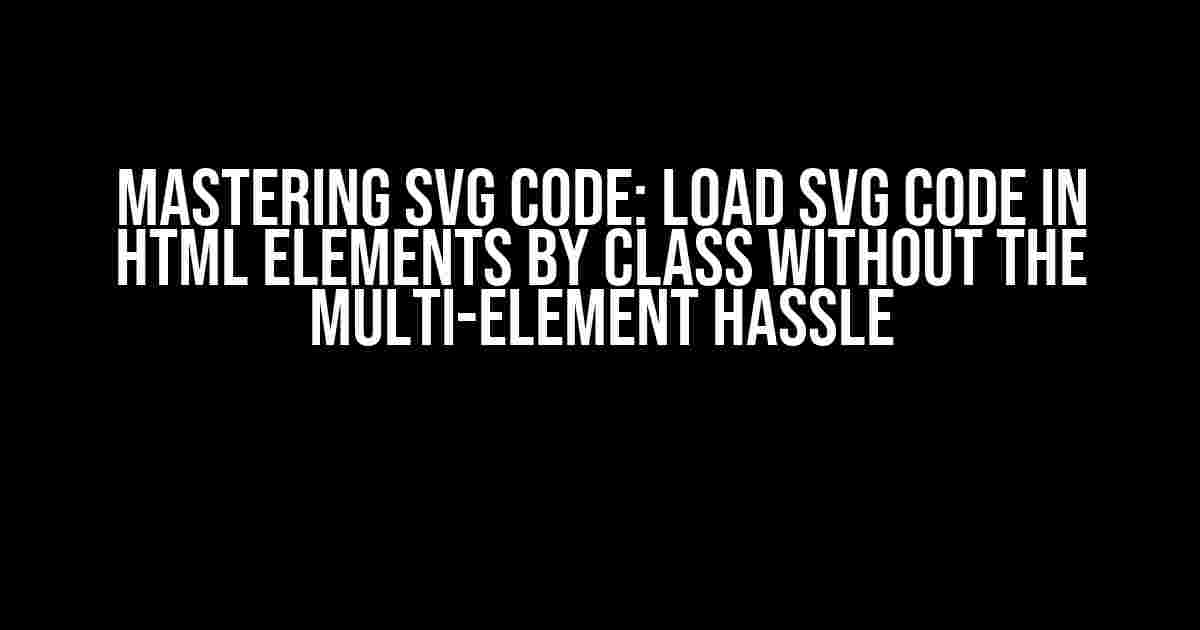Are you tired of struggling to load SVG code in HTML elements by class, only to find yourself stuck when trying to select multiple elements with the same class? Look no further! In this comprehensive guide, we’ll demystify the process, providing you with clear and direct instructions to overcome this common obstacle.
- Understanding the Problem: Selecting Multiple Elements with the Same Class
- Solution: Using a Unique Identifier for Each Element
- A Better Solution: Using JavaScript to Iterate over Elements with the Same Class
- Loading SVG Code from an External File
- Optimizing Performance: Caching and Lazy Loading
- Conclusion
Understanding the Problem: Selecting Multiple Elements with the Same Class
When working with SVG code in HTML, you may encounter a situation where you need to load the same SVG code into multiple elements with the same class. Sounds simple, right? However, this can quickly become a headache when trying to target these elements using JavaScript or CSS. The issue arises because most methods used to select elements by class return a single element, rather than an array of elements.
For example, using JavaScript’s document.getElementsByClassName() method will return an HTMLCollection, which is not an array, making it difficult to iterate over the elements. Similarly, using CSS selectors with a class selector will only target the first element with that class.
const elements = document.getElementsByClassName('my-svg-class');
// elements is an HTMLCollection, not an array
const elements = document.querySelectorAll('.my-svg-class');
// only targets the first element with the class "my-svg-class"Solution: Using a Unique Identifier for Each Element
One approach to load SVG code in HTML elements by class is to use a unique identifier for each element. This can be achieved by adding a distinct id attribute to each element. While this method works, it can become cumbersome, especially when dealing with a large number of elements.
<div id="svg-element-1" class="my-svg-class"></div>
<div id="svg-element-2" class="my-svg-class"></div>
<div id="svg-element-3" class="my-svg-class"></div>A Better Solution: Using JavaScript to Iterate over Elements with the Same Class
A more efficient approach is to use JavaScript to iterate over elements with the same class. This can be achieved using the forEach() method or a traditional for loop.
const elements = document.querySelectorAll('.my-svg-class');
elements.forEach((element) => {
// load SVG code into each element
const svgCode = '<svg><circle cx="50" cy="50" r="40"></circle></svg>';
element.innerHTML = svgCode;
});Using a Function to Load SVG Code
Rather than repeating the SVG code within the JavaScript, it’s a good practice to create a separate function to load the SVG code. This keeps your code organized and makes it easier to maintain.
function loadSvgCode(element) {
const svgCode = '<svg><circle cx="50" cy="50" r="40"></circle></svg>';
element.innerHTML = svgCode;
}
const elements = document.querySelectorAll('.my-svg-class');
elements.forEach((element) => {
loadSvgCode(element);
});Loading SVG Code from an External File
In many cases, you may want to load SVG code from an external file, rather than hardcoding it into your JavaScript. This can be achieved using the fetch() API or an XMLHttpRequest.
function loadSvgCode(element, filePath) {
fetch(filePath)
.then(response => response.text())
.then((svgCode) => {
element.innerHTML = svgCode;
});
}
const elements = document.querySelectorAll('.my-svg-class');
elements.forEach((element) => {
loadSvgCode(element, 'path/to/svg/file.svg');
});Handling SVG Code from an External File
When loading SVG code from an external file, you’ll need to ensure that the file is properly formatted and accessible. Here are some tips to keep in mind:
- Make sure the SVG file is encoded in UTF-8 and has the correct MIME type (image/svg+xml).
- Use a relative or absolute path to the SVG file, depending on your project’s structure.
- If using a CDN or external server, ensure that CORS is enabled to avoid browser security restrictions.
Optimizing Performance: Caching and Lazy Loading
When loading SVG code into multiple elements, it’s essential to optimize performance to avoid slowing down your website. Two techniques to achieve this are caching and lazy loading.
Caching SVG Code
Caching the SVG code can significantly improve performance by reducing the number of requests made to the server. This can be achieved using the browser’s cache or a caching library like cache-polyfill.
const cache = {};
function loadSvgCode(element, filePath) {
if (cache[filePath]) {
element.innerHTML = cache[filePath];
} else {
fetch(filePath)
.then(response => response.text())
.then((svgCode) => {
cache[filePath] = svgCode;
element.innerHTML = svgCode;
});
}
}Lazy loading involves loading the SVG code only when it’s needed, rather than loading it all at once. This can be achieved using techniques like intersection observer or scroll events.
const elements = document.querySelectorAll('.my-svg-class');
elements.forEach((element) => {
const observer = new IntersectionObserver((entries) => {
if (entries[0].isIntersecting) {
loadSvgCode(element, 'path/to/svg/file.svg');
}
}, {
threshold: 1.0,
});
observer.observe(element);
});Conclusion
Loading SVG code in HTML elements by class can be a challenging task, especially when dealing with multiple elements with the same class. However, by using JavaScript to iterate over elements, creating a separate function to load SVG code, and optimizing performance through caching and lazy loading, you can overcome these obstacles and master the art of SVG code loading.
| Method | Advantages | Disadvantages |
|---|---|---|
| Using a unique identifier for each element | Easier to implement, suitable for small number of elements | Can become cumbersome, not scalable |
| Using JavaScript to iterate over elements with the same class | Flexible, scalable, suitable for large number of elements | Requires JavaScript knowledge, may have performance implications |
| Loading SVG code from an external file | Allows for easy maintenance, updates to SVG code | May require additional setup, CORS configuration |
| Caching and lazy loading | Improves performance, reduces server requests | May require additional complexity, caching library setup |
By following these guidelines and best practices, you’ll be well on your way to mastering the art of loading SVG code in HTML elements by class, without the hassle of dealing with multiple elements with the same class.
- Use JavaScript to iterate over elements with the same class.
- Create a separate function to load SVG code.
- Optimize performance using caching and lazy loading.
- Consider using a unique identifier for each element, if necessary.
Remember, with great power comes great responsibility. Use your newfound knowledge wisely, and happy coding!
Here are 5 questions and answers about “Load SVG code in HTML elements by class, can’t select multiple elements with the same class”
Frequently Asked Question
Get answers to your burning questions about loading SVG code in HTML elements by class and why you can’t select multiple elements with the same class.
Why can’t I select multiple elements with the same class to load SVG code?
When you try to select multiple elements with the same class to load SVG code, it’s because the selector is only targeting the first element with that class. To overcome this, you need to use a loop or an array to target all elements with the same class.
How do I target multiple elements with the same class to load SVG code?
You can use JavaScript to target multiple elements with the same class. For example, `document.querySelectorAll(‘.myClass’)` will select all elements with the class `myClass`. Then, you can loop through the resulting NodeList to load the SVG code for each element.
Can I use CSS to load SVG code in HTML elements by class?
Unfortunately, CSS alone can’t be used to load SVG code in HTML elements by class. CSS is used for styling, not for adding content. You need to use JavaScript or another programming language to dynamically add the SVG code to the elements.
What’s the best way to load SVG code in HTML elements by class?
The best way to load SVG code in HTML elements by class is to use JavaScript to target the elements and then use the `innerHTML` property to add the SVG code. You can also use a library like D3.js to make the process easier and more efficient.
Will loading SVG code in HTML elements by class affect page performance?
Loading SVG code in HTML elements by class can affect page performance if not done efficiently. To minimize the impact, make sure to use a efficient looping method and consider using a library like D3.js, which is optimized for performance. Also, consider lazy loading the SVG code to reduce the initial load time.




